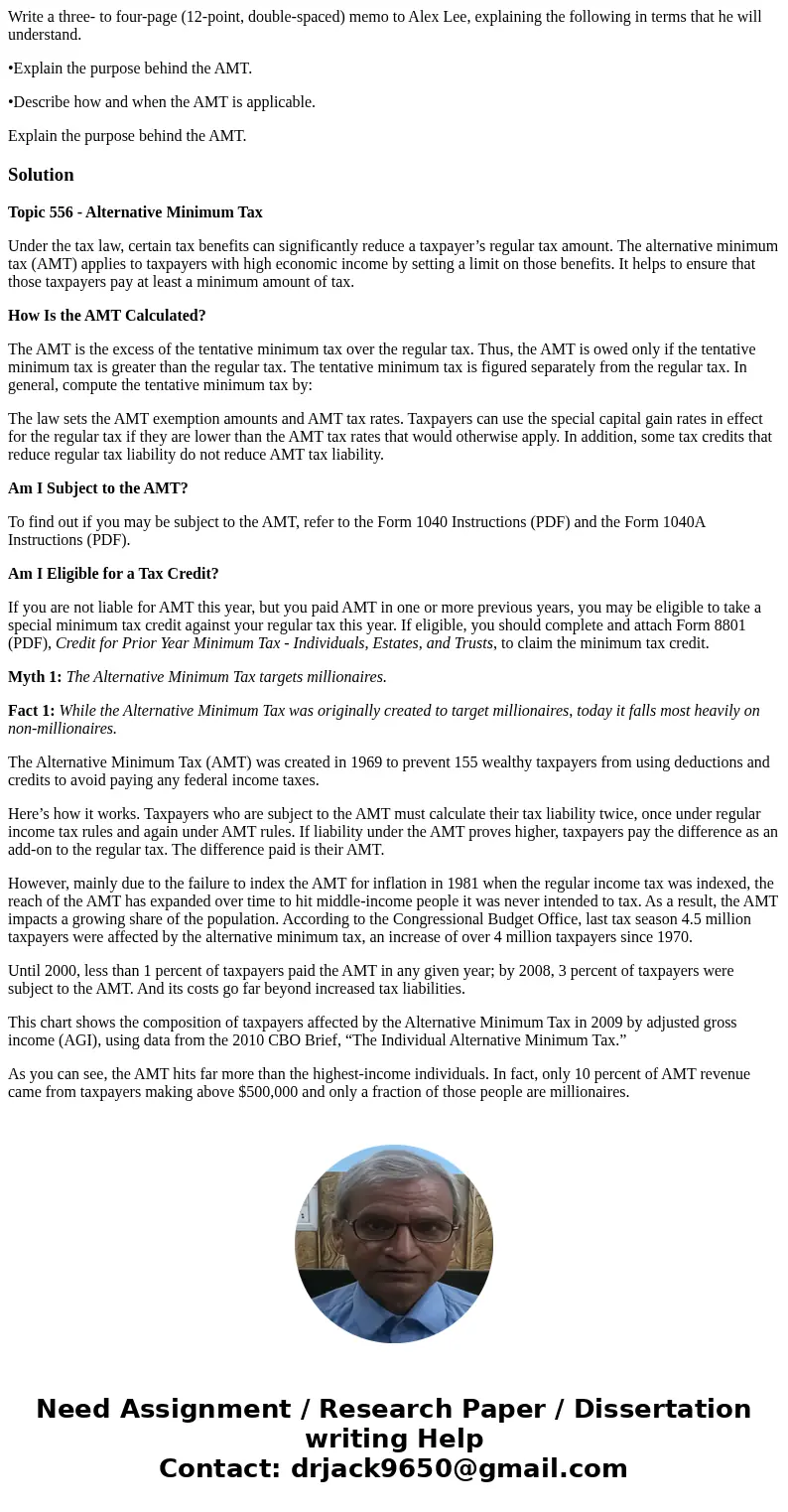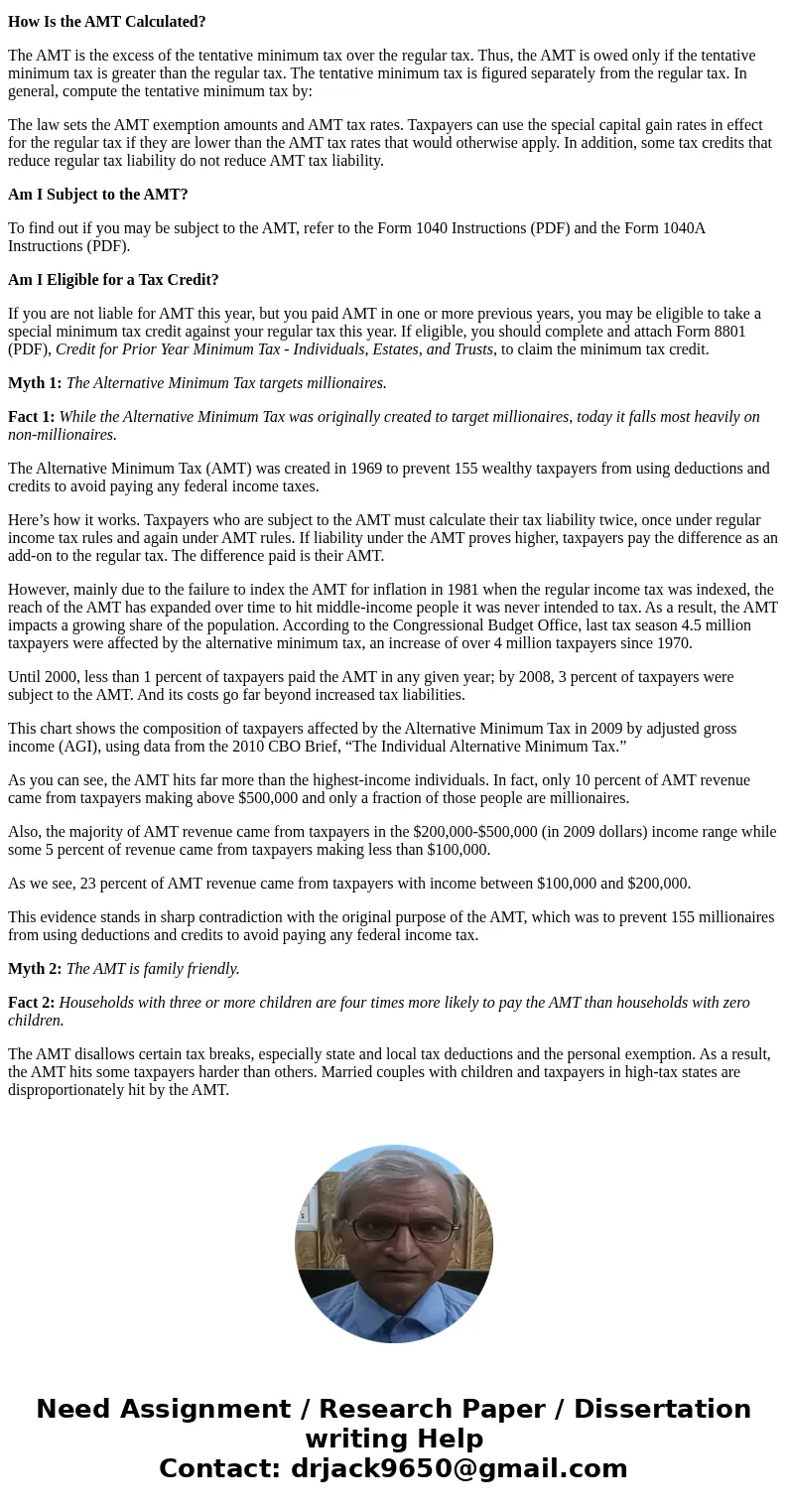Write a three to fourpage 12point doublespaced memo to Alex
Write a three- to four-page (12-point, double-spaced) memo to Alex Lee, explaining the following in terms that he will understand.
•Explain the purpose behind the AMT.
•Describe how and when the AMT is applicable.
Explain the purpose behind the AMT.
Solution
Topic 556 - Alternative Minimum Tax
Under the tax law, certain tax benefits can significantly reduce a taxpayer’s regular tax amount. The alternative minimum tax (AMT) applies to taxpayers with high economic income by setting a limit on those benefits. It helps to ensure that those taxpayers pay at least a minimum amount of tax.
How Is the AMT Calculated?
The AMT is the excess of the tentative minimum tax over the regular tax. Thus, the AMT is owed only if the tentative minimum tax is greater than the regular tax. The tentative minimum tax is figured separately from the regular tax. In general, compute the tentative minimum tax by:
The law sets the AMT exemption amounts and AMT tax rates. Taxpayers can use the special capital gain rates in effect for the regular tax if they are lower than the AMT tax rates that would otherwise apply. In addition, some tax credits that reduce regular tax liability do not reduce AMT tax liability.
Am I Subject to the AMT?
To find out if you may be subject to the AMT, refer to the Form 1040 Instructions (PDF) and the Form 1040A Instructions (PDF).
Am I Eligible for a Tax Credit?
If you are not liable for AMT this year, but you paid AMT in one or more previous years, you may be eligible to take a special minimum tax credit against your regular tax this year. If eligible, you should complete and attach Form 8801 (PDF), Credit for Prior Year Minimum Tax - Individuals, Estates, and Trusts, to claim the minimum tax credit.
Myth 1: The Alternative Minimum Tax targets millionaires.
Fact 1: While the Alternative Minimum Tax was originally created to target millionaires, today it falls most heavily on non-millionaires.
The Alternative Minimum Tax (AMT) was created in 1969 to prevent 155 wealthy taxpayers from using deductions and credits to avoid paying any federal income taxes.
Here’s how it works. Taxpayers who are subject to the AMT must calculate their tax liability twice, once under regular income tax rules and again under AMT rules. If liability under the AMT proves higher, taxpayers pay the difference as an add-on to the regular tax. The difference paid is their AMT.
However, mainly due to the failure to index the AMT for inflation in 1981 when the regular income tax was indexed, the reach of the AMT has expanded over time to hit middle-income people it was never intended to tax. As a result, the AMT impacts a growing share of the population. According to the Congressional Budget Office, last tax season 4.5 million taxpayers were affected by the alternative minimum tax, an increase of over 4 million taxpayers since 1970.
Until 2000, less than 1 percent of taxpayers paid the AMT in any given year; by 2008, 3 percent of taxpayers were subject to the AMT. And its costs go far beyond increased tax liabilities.
This chart shows the composition of taxpayers affected by the Alternative Minimum Tax in 2009 by adjusted gross income (AGI), using data from the 2010 CBO Brief, “The Individual Alternative Minimum Tax.”
As you can see, the AMT hits far more than the highest-income individuals. In fact, only 10 percent of AMT revenue came from taxpayers making above $500,000 and only a fraction of those people are millionaires.
Also, the majority of AMT revenue came from taxpayers in the $200,000-$500,000 (in 2009 dollars) income range while some 5 percent of revenue came from taxpayers making less than $100,000.
As we see, 23 percent of AMT revenue came from taxpayers with income between $100,000 and $200,000.
This evidence stands in sharp contradiction with the original purpose of the AMT, which was to prevent 155 millionaires from using deductions and credits to avoid paying any federal income tax.
Myth 2: The AMT is family friendly.
Fact 2: Households with three or more children are four times more likely to pay the AMT than households with zero children.
The AMT disallows certain tax breaks, especially state and local tax deductions and the personal exemption. As a result, the AMT hits some taxpayers harder than others. Married couples with children and taxpayers in high-tax states are disproportionately hit by the AMT.


 Homework Sourse
Homework Sourse